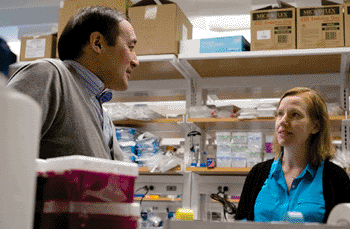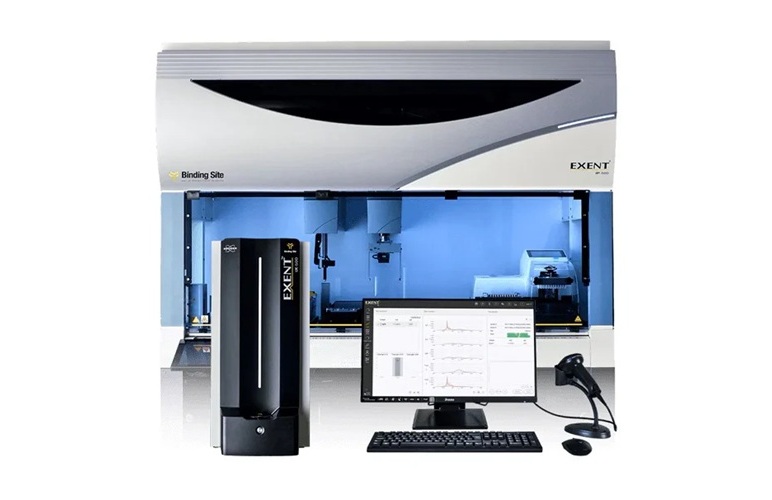Replenishment of GDF11 Reverses Cardiac Hypertrophy in Aging Animals
|
By LabMedica International staff writers Posted on 22 May 2013 |

Image: Senior author Dr. Richard Lee (left) with contributing author Dr. Amy J. Wagers (right) (Photo courtesy of Harvard University).
Experimental data collected by a team of cardiovascular disease researchers identified the decline in levels of the blood-borne protein growth differentiation factor 11 (GDF11) as contributing to deterioration of the heart muscle (cardiac hypertrophy) that occurs with advanced age and showed that restoration of GDF11 could reverse this process.
Investigators at Harvard University (Boston, MA, USA) searched for factors leading to the development of cardiac hypertrophy by using heterochronic parabiosis, a surgical technique in which joining of animals of different ages leads to a shared circulation.
The circulatory systems of old and young mice were surgically joined. After four weeks of exposure to the circulation of young mice, indicators of cardiac hypertrophy in old mice dramatically regressed. Changes included reduced cardiomyocyte size and molecular remodeling. This reversal of age-related hypertrophy was not attributable to hemodynamic or behavioral effects of the parabiosis procedure, implicating a blood-borne factor.
The investigators used modified aptamer-based proteomics to identify the TGF-beta superfamily member GDF11 as a circulating factor in young mice that declined with age. Aptamers are nucleic acid species that have been engineered through repeated rounds of in vitro selection to bind to various molecular targets such as small molecules, proteins, and nucleic acids. Aptamers are useful in biotechnological and therapeutic applications as they offer molecular recognition properties that rival that of antibodies. In addition to their discriminate recognition, aptamers offer advantages over antibodies as they can be engineered completely in a test tube, are readily produced by chemical synthesis, possess desirable storage properties, and elicit little or no immunogenicity in therapeutic applications.
GDF11 is a member of the bone morphogenetic protein (BMP) family and the TGF-beta (transforming growth factor beta) superfamily. This group of proteins is characterized by a polybasic proteolytic processing site, which is cleaved to produce a mature protein containing seven conserved cysteine residues. The members of this family are regulators of cell growth and differentiation in both embryonic and adult tissues. Studies in animals suggest that this protein is involved in mesodermal formation and neurogenesis during embryonic development.
Results published in the May 9, 2013, online edition of the journal Cell revealed that treatment of old mice that restored GDF11 to youthful levels replicated the effects of parabiosis by reversing age-related hypertrophy, a finding that implies a possible therapeutic use for this protein in geriatric medicine.
"There has been evidence that circulating bloodstream factors exist in mammals that can rejuvenate tissues, but they have not been identified. This study found the first factor like this," said senior study author Dr. Richard Lee, professor of medicine at Harvard University.
Related Links:
Harvard University
Investigators at Harvard University (Boston, MA, USA) searched for factors leading to the development of cardiac hypertrophy by using heterochronic parabiosis, a surgical technique in which joining of animals of different ages leads to a shared circulation.
The circulatory systems of old and young mice were surgically joined. After four weeks of exposure to the circulation of young mice, indicators of cardiac hypertrophy in old mice dramatically regressed. Changes included reduced cardiomyocyte size and molecular remodeling. This reversal of age-related hypertrophy was not attributable to hemodynamic or behavioral effects of the parabiosis procedure, implicating a blood-borne factor.
The investigators used modified aptamer-based proteomics to identify the TGF-beta superfamily member GDF11 as a circulating factor in young mice that declined with age. Aptamers are nucleic acid species that have been engineered through repeated rounds of in vitro selection to bind to various molecular targets such as small molecules, proteins, and nucleic acids. Aptamers are useful in biotechnological and therapeutic applications as they offer molecular recognition properties that rival that of antibodies. In addition to their discriminate recognition, aptamers offer advantages over antibodies as they can be engineered completely in a test tube, are readily produced by chemical synthesis, possess desirable storage properties, and elicit little or no immunogenicity in therapeutic applications.
GDF11 is a member of the bone morphogenetic protein (BMP) family and the TGF-beta (transforming growth factor beta) superfamily. This group of proteins is characterized by a polybasic proteolytic processing site, which is cleaved to produce a mature protein containing seven conserved cysteine residues. The members of this family are regulators of cell growth and differentiation in both embryonic and adult tissues. Studies in animals suggest that this protein is involved in mesodermal formation and neurogenesis during embryonic development.
Results published in the May 9, 2013, online edition of the journal Cell revealed that treatment of old mice that restored GDF11 to youthful levels replicated the effects of parabiosis by reversing age-related hypertrophy, a finding that implies a possible therapeutic use for this protein in geriatric medicine.
"There has been evidence that circulating bloodstream factors exist in mammals that can rejuvenate tissues, but they have not been identified. This study found the first factor like this," said senior study author Dr. Richard Lee, professor of medicine at Harvard University.
Related Links:
Harvard University
Latest BioResearch News
- Genome Analysis Predicts Likelihood of Neurodisability in Oxygen-Deprived Newborns
- Gene Panel Predicts Disease Progession for Patients with B-cell Lymphoma
- New Method Simplifies Preparation of Tumor Genomic DNA Libraries
- New Tool Developed for Diagnosis of Chronic HBV Infection
- Panel of Genetic Loci Accurately Predicts Risk of Developing Gout
- Disrupted TGFB Signaling Linked to Increased Cancer-Related Bacteria
- Gene Fusion Protein Proposed as Prostate Cancer Biomarker
- NIV Test to Diagnose and Monitor Vascular Complications in Diabetes
- Semen Exosome MicroRNA Proves Biomarker for Prostate Cancer
- Genetic Loci Link Plasma Lipid Levels to CVD Risk
- Newly Identified Gene Network Aids in Early Diagnosis of Autism Spectrum Disorder
- Link Confirmed between Living in Poverty and Developing Diseases
- Genomic Study Identifies Kidney Disease Loci in Type I Diabetes Patients
- Liquid Biopsy More Effective for Analyzing Tumor Drug Resistance Mutations
- New Liquid Biopsy Assay Reveals Host-Pathogen Interactions
- Method Developed for Enriching Trophoblast Population in Samples
Channels
Clinical Chemistry
view channel
Chemical Imaging Probe Could Track and Treat Prostate Cancer
Prostate cancer remains a leading cause of illness and death among men, with many patients eventually developing resistance to standard hormone-blocking therapies. These drugs often lose effectiveness... Read more
Mismatch Between Two Common Kidney Function Tests Indicates Serious Health Problems
Creatinine has long been the standard for measuring kidney filtration, while cystatin C — a protein produced by all human cells — has been recommended as a complementary marker because it is influenced... Read moreMolecular Diagnostics
view channel
Blood Test to Help Low-Risk Gastric Cancer Patients Avoid Unnecessary Surgery
Accurately identifying lymph node metastasis in early-stage gastric cancer remains a major clinical challenge. CT imaging often misses up to half of lymph node–positive cases, leading clinicians to recommend... Read more
First-Of-Its-Kind Automated System Speeds Myeloma Diagnosis
More than 176,000 people are diagnosed with multiple myeloma worldwide each year, yet the current diagnostic pathway can be slow and uncertain, often relying on a highly subjective interpretation of test results.... Read moreHematology
view channel
Platelet Activity Blood Test in Middle Age Could Identify Early Alzheimer’s Risk
Early detection of Alzheimer’s disease remains one of the biggest unmet needs in neurology, particularly because the biological changes underlying the disorder begin decades before memory symptoms appear.... Read more
Microvesicles Measurement Could Detect Vascular Injury in Sickle Cell Disease Patients
Assessing disease severity in sickle cell disease (SCD) remains challenging, especially when trying to predict hemolysis, vascular injury, and risk of complications such as vaso-occlusive crises.... Read more
ADLM’s New Coagulation Testing Guidance to Improve Care for Patients on Blood Thinners
Direct oral anticoagulants (DOACs) are one of the most common types of blood thinners. Patients take them to prevent a host of complications that could arise from blood clotting, including stroke, deep... Read moreImmunology
view channel
Gene Signature Test Predicts Response to Key Breast Cancer Treatment
DK4/6 inhibitors paired with hormone therapy have become a cornerstone treatment for advanced HR+/HER2– breast cancer, slowing tumor growth by blocking key proteins that drive cell division.... Read more
Chip Captures Cancer Cells from Blood to Help Select Right Breast Cancer Treatment
Ductal carcinoma in situ (DCIS) accounts for about a quarter of all breast cancer cases and generally carries a good prognosis. This non-invasive form of the disease may or may not become life-threatening.... Read moreMicrobiology
view channel
Rapid Assay Identifies Bloodstream Infection Pathogens Directly from Patient Samples
Bloodstream infections in sepsis progress quickly and demand rapid, precise diagnosis. Current blood-culture methods often take one to five days to identify the pathogen, leaving clinicians to treat blindly... Read more
Blood-Based Molecular Signatures to Enable Rapid EPTB Diagnosis
Extrapulmonary tuberculosis (EPTB) remains difficult to diagnose and treat because it spreads beyond the lungs and lacks easily accessible biomarkers. Despite TB infecting 10 million people yearly, the... Read more
15-Minute Blood Test Diagnoses Life-Threatening Infections in Children
Distinguishing minor childhood illnesses from potentially life-threatening infections such as sepsis or meningitis remains a major challenge in emergency care. Traditional tests can take hours, leaving... Read more
High-Throughput Enteric Panels Detect Multiple GI Bacterial Infections from Single Stool Swab Sample
Gastrointestinal (GI) infections are among the most common causes of illness worldwide, leading to over 1.7 million deaths annually and placing a heavy burden on healthcare systems. Conventional diagnostic... Read morePathology
view channel
AI Tool Outperforms Doctors in Spotting Blood Cell Abnormalities
Diagnosing blood disorders depends on recognizing subtle abnormalities in cell size, shape, and structure, yet this process is slow, subjective, and requires years of expert training. Even specialists... Read more
AI Tool Rapidly Analyzes Complex Cancer Images for Personalized Treatment
Complex digital biopsy images that typically take an expert pathologist up to 20 minutes to assess can now be analyzed in about one minute using a new artificial intelligence (AI) tool. The technology... Read moreTechnology
view channel
AI Saliva Sensor Enables Early Detection of Head and Neck Cancer
Early detection of head and neck cancer remains difficult because the disease produces few or no symptoms in its earliest stages, and lesions often lie deep within the head or neck, where biopsy or endoscopy... Read more
AI-Powered Biosensor Technology to Enable Breath Test for Lung Cancer Detection
Detecting lung cancer early remains one of the biggest challenges in oncology, largely because current tools are invasive, expensive, or unable to identify the disease in its earliest phases.... Read moreIndustry
view channel
Abbott Acquires Cancer-Screening Company Exact Sciences
Abbott (Abbott Park, IL, USA) has entered into a definitive agreement to acquire Exact Sciences (Madison, WI, USA), enabling it to enter and lead in fast-growing cancer diagnostics segments.... Read more
























